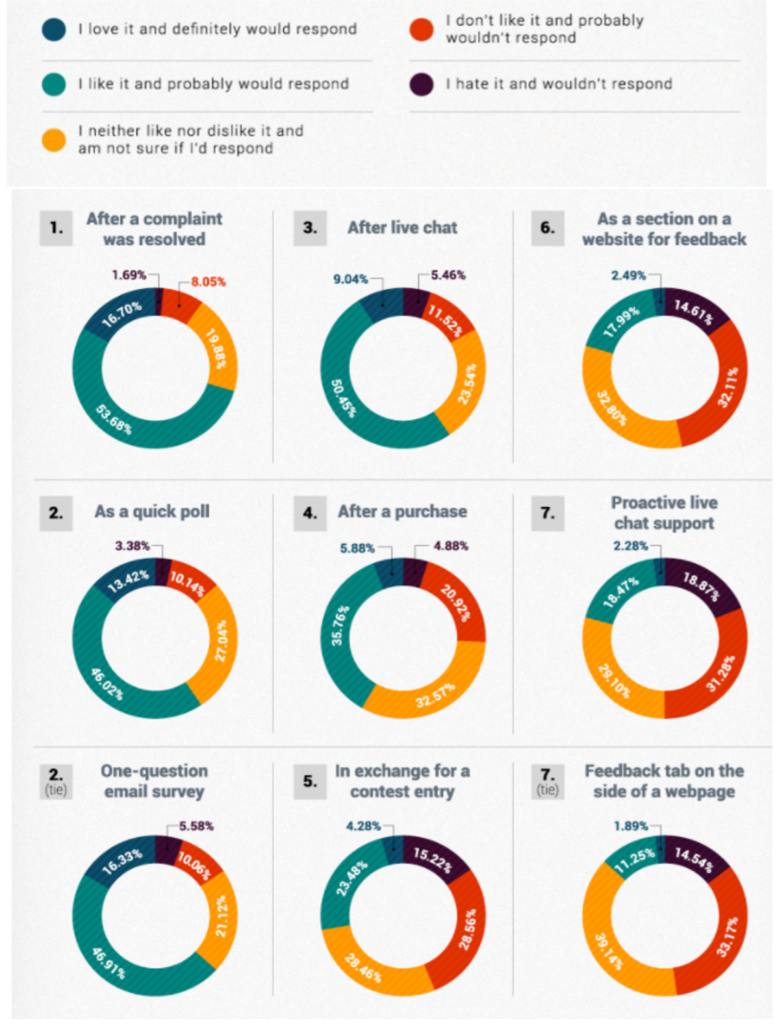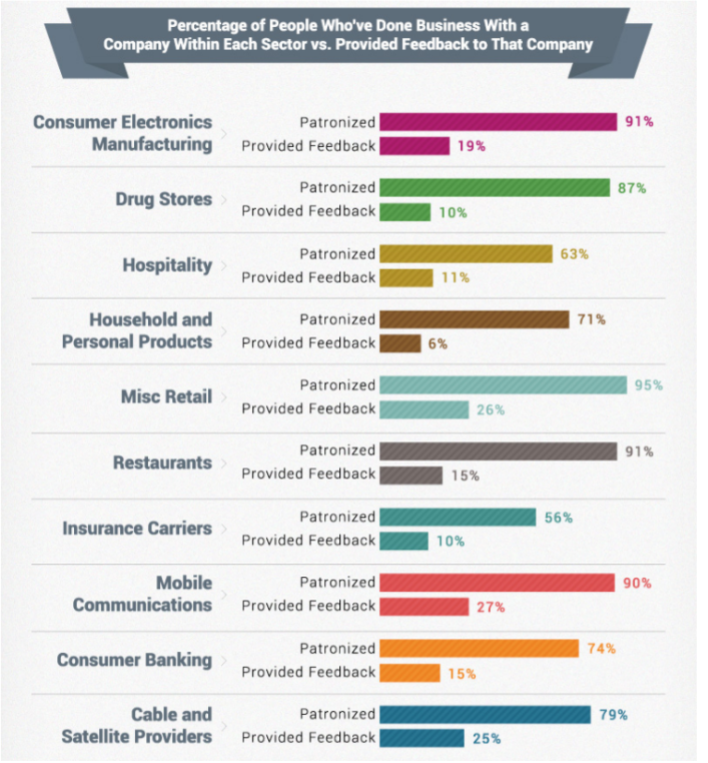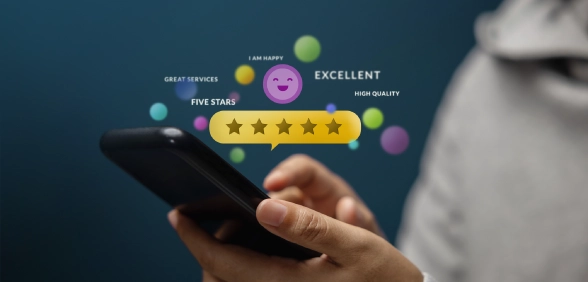Survey fatigue is often the culprit when companies fail to build effective customer feedback programs.
The impact of survey fatigue is:
- Inconsistent and limited feedback data, making it difficult to measure and improve your customers’ experience.
- Impeded decision making based on customer feedback.
This article will walk you through the six best-practice tips to overcome survey fatigue. Using these best-practice tips will help your organisation overcome low engagement levels and low-quality customer feedback.
What is Survey Fatigue?
Survey fatigue is defined as the time and effort involved in participating in a survey. This definition comes from Sharp and Frankel (1983), two scholars of the psychology world. They theorised and later proved that survey fatigue, if left unmanaged, can significantly impact survey response rates and the quality of feedback.
Commonly survey fatigue can start at two points during the respondent’s journey:
- Before the customer takes the survey as they may receive multiple surveys at short intervals
- During the survey when respondents find it to be tedious and time-consuming.
How survey fatigue hurts customer feedback programs
Low engagement is a common problem caused by survey response fatigue and providing feedback becomes tiresome for customers. Other negative consequences include:
- Negative brand perceptions: Plying your contact list with surveys can damage your brand reputation. If you need feedback, ask for it sparingly.
- Low data quality: As motivation and engagement drop, so does the quality of responses. Respondents will attempt to finish your survey quicker and pay less attention to their answers.
- Non-response bias: Respondents are less likely to be affected by fatigue when they want their voices heard. This effect seems positive, but in fact, it can lead to a data set filled with extreme opinions.
- Skews insights and improvement initiatives: Survey fatigue often means lower response and completion rates. Survey fatigue can also cause response bias, speed runs, acquiescence response bias, extreme responding or neutral answer selection bias.
Six Best-practice tips to overcome survey fatigue
To build an outstanding customer experience, we need to understand what delights our customers and causes pain.
A simple step of ‘activating’ customer feedback programs gets us on the track in understanding and improving the customer experience.
Achieving an organic and consistent flow of customer feedback is vital to any customer feedback program’s success. Adequate feedback from our customers allows us to dive through their data confidently to get qualified insights into their experience.
The more feedback we have, the more confidently we can unpack the experience for all our customers rather than a select few cohorts.
“Having the right timing and survey design can help us avoid or overcome survey fatigue.”
Here are six best practice tips to use before sending a survey and during the survey to avoid survey fatigue:
Before sending a survey
1. Ask for feedback at the right time
We must make it as convenient as possible for our customers to recollect their interaction with our brand. You will avoid survey fatigue by making recollection easier. This approach will increase the likelihood that they will provide quality feedback about their experience. The shorter the time between interaction and feedback requests, the easier it will be for our customers to recollect their experience and provide us feedback.
Pro Tip: Setup automated event-based triggers to assure you are sending feedback requests to customers at the right time every time. (Click here to discuss with our CX Experts how we can help make sure you always send feedback requests at the right time).
Best Practice for timings
Timing is essential to overcome survey fatigue as it accounts for your customer’s receptiveness to provide quality feedback.
- B2B Scenarios – Solicit for feedback quarterly as B2B audiences generally interact much less with a company than a B2C audience.
- B2C Scenarios – You should survey them twice as many times as you interact with them.
- Transactional Surveys – Post purchase is preferred – but it is better to keep it short and succinct to keep soliciting feedback in the future.

2. Avoid the noise! – Reach out to the right audience
Mass solicitation of feedback from our customer base usually results in minimal engagement and low-quality feedback. To avoid survey fatigue we must use segmentation. Segmentation is a targeted approach to solicit feedback mainly from customers who would be most willing to provide quality feedback regarding their experience.
Pro Tip: A good place to start would be with all customers part of your loyalty program or newsletter mailing lists. This group of customers would have the most substantial interest in providing you with timely and quality feedback.
3. Make Feedback requests personal and sincere to ensure that they’re appreciated and valued on an individual level
Customers tend to react more positively to personal requests as they feel they are valued and respected on an individual level. Addressing customers by their first name and referencing their recent interaction shows that the organisation appreciates their business and is willing to hear and address their feedback.
Pro Tip: Personalise surveys – leverage data within your CRMs and customer databases. Additionally, having the company’s CEO name and signature present in the feedback request helps highlight to customers that their feedback is heard to the top!
During the survey
4. Keep the Respondent experience short and pleasant

Consumers generally do not want to provide us feedback as they always have various urgent and important matters crowding their headspace.
Pro Tip: Limit the Survey design to three pages, where the first page has the primary customer experience metric (NPS/CSAT) with a text box to allow respondents to provide a rationale for their score, followed by a page measuring satisfaction of 5-6 main attributes of the experience followed by the last page allowing respondents to scribe any improvement suggestions. This 3-page approach has proven a great success for our clients, getting them an organic, consistent, and qualitative flow of feedback.
5. Keep survey questions short and simple for respondents to quickly understand and answer
As mentioned previously, consumers, in general, are time poor and this is why survey fatigue is common. 60% of customers say they do not want to take a survey longer than 10 mins and 87% say the same for a survey longer than 20 minutes.
Having long, complicated or loaded questions can frustrate consumers who have taken out a portion of their valuable time to provide us feedback and can also often lead to them giving biased answers due to the survey design rather than their experience with your organisation.
Pro Tip: Surveys should be mobile-friendly, simple to understand and easy to answer. Using simple one-sentence questions on a 5-point Likert scale that measures a single experience attribute per question is helpful. This question format will capture customer perception and will be easy for respondents to interpret and answer.
6. Allow Respondents to choose what they can answer
Previous studies have shown that respondents who cannot skip questions are likely to drop off from the survey. Thus, it is crucial to ensure we provide the flexibility to our respondents to choose what questions they answer and can partially submit or complete a survey later.
Pro tip: While designing your surveys, make sure the survey questions are optional and that respondent can choose “Not Applicable” for their answers. Additionally, allowing respondents to submit partially completed surveys and have the option of completing them later will enable them to provide qualitative feedback at their own pace and convenience.
A little goes a long way!
These six best practice tips can drastically improve the quantity of feedback and help you overcome survey fatigue. The tips will promote a consistent and organic flow of qualitative feedback from customers.
If you would like to know more about how Resonate’s Customer Experience platform can help your organisation improve your customer engagement levels and get more mileage out of your customer feedback programs, one of our CX experts would be happy to chat with you.
Learn how Resonate achieves industry-leading survey response rates and request a demo today!







